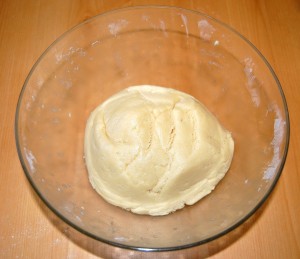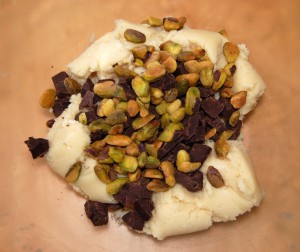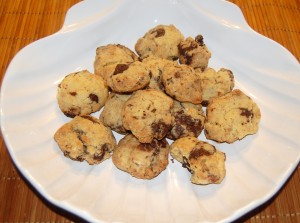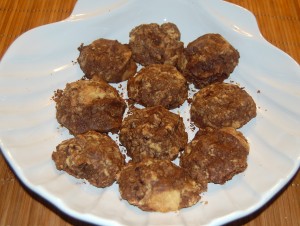We have little baking experience, so we’re just beginning to learn how to make Perfect Health Diet compliant doughs and baked goods. This recipe turned out very well — unexpectedly well considering it was our first try. And it’s so easy; it takes less than half an hour.
Ingredients
Dry ingredients:
- Rice flour 1 cup (optional: sticky rice flour)
- Tapioca flour 1/3 cup
- Baking soda 1/2 tsp
- (optional) Beef gelatin 1 tablespoon
Wet ingredients:
- Butter ½ cup (1 stick)
- Egg yolks 3
- Rice syrup 1/4 to 1/3 cup
- Vanilla ¼ tsp
Flavorings
- Chocolate chips
- (optional) pistachios
- (optional) raisins
- (optional) pomegranate seeds
Preparation
Melt the butter (we used the microwave, about 20 seconds) in a mixing bowl. Add the other wet ingredients and mix thoroughly.
Mix in the dry ingredients until the dough has an even consistency. It will look like this:
Then fold in some flavorings. We broke up some bulk dark chocolate and included pistachios:
In another batch we tried chocolate covered raisins:
Place cookie-sized batches on an aluminum foil lined baking sheet:
The aluminum foil prevents the bottom of the cookies from burning.
Bake at 375 F for 10-12 minutes. Remove the cookies and let them cool for at least half an hour; after they are cooled, refrigerate them.
This was the chocolate and pistachio batch:
The chocolate covered raisins melted and produced brown cookies:
Post-eatem
The cookies were good – we were surprised how well they came out on our first attempt.
Shou-Ching really loved them, and so did our guests, but I thought the texture was drier and more crumbly than I would like. (Of course, I used to prefer uncooked dough to cookies, so I like things chewy.) This is a general issue with rice flour – it doesn’t hold together as well as gluten-containing flours. We tried both sticky rice flour and regular rice flour; I think the sticky rice flour might be very slightly better but it was difficult to detect a difference.
Here are some tweaks we’ll try next time:
- Add more egg yolks. A little more fat might give a moister texture.
- Try potato starch in place of tapioca flour.
- Experiment with the protein. Most recipes either have no protein or use egg whites. We like the idea of a balanced mix of macronutrients, so we wanted to include a bit of protein. We tried the beef gelatin, partly because we have some around, and partly because gelatin mixed with water makes a good glue. We wondered if this might help the rice dough cohere. As yet we haven’t tested enough variations to know whether this was a good or bad idea.
We’d love to hear tips from more experienced cookie chefs – and reviews from the most honest critics, young children!

















Paul,
You might try a mashed ripe banana-(put in the freezer to increase sweetness). I make a great almond flour blueberry muffin sweetened with only bananas for a friend who has cancer and has cut out refined sugar.
The bananas make them nice and moist-of course rice flour is a whole ‘nother animal.
Ditto apple sauce.
Hi Paul
Baking is a serious hobby of mine, I actually went through a professional pastry program. But I found myself playing around with more GF recipes ever since I cut gluten from my diet.
The dryness isn’t from lack of fat, as you have 1 stick of butter in your recipe. The main issue with gluten-free baked goods is indeed the dryness factor, that along with too-crumbly (gritty) texture are the main complaints of GF baked goods. The small amount of gluten really does make a difference.
But grittiness/ dryness can be ameliorated or eliminated by adding more liquid AND small amount of xanthum gum. Xanthum gum is a liquid stabilizer used in ice cream and many baked goods. It also serves to prevent watery liquids and oil from separating. One problem with adding more fat to GF cookie recipes is that you tend to end up with flat, greasy (not moist), heavy cookies….not appetizing at all. For moistness/ mouth feel, as I personally like soft, chewy cookies, it’s more important to add liquid in form of coconut milk, whole eggs not just yolks. In fact just adding yolks make all GF baked goods taste like hockey pucks.
Have you tried baking with coconut flour? I make most of my GF baked goods with coconut flour and/ or finely ground almond meal. The trick with coconut flour is it absorbs lots of liquid/ fat/ eggs, so you have to had extra amounts of those ingredients PLUS a stabilizer such as xanthum gum. I buy all my GF ingredients from Amazon btw.
I have been gluten free for 3 years. I have learned
much visiting gluten free blogs.
In the beginning I did use the “gums.” However,
I find I am sensitive to them.
I haven’t made cookies lately.
Yet, I have made great biscuits. I found this recipe on a blog. Sadly, I can’t give credit as
I don’t remember. Anyway, it would be simple to
convert this recipe to cookies.
1 1/2 cups rice flour
3/4 Potato starch
1 Tablespoon baking powder
3/4 tsp salt
1/2 cup butter (1 stick)
1 cup milk more/less
Blend dry ingredients. Add cold butter “leave in small chunks” this will add to flakiness.
Add milk to desired consistency. I prefer a tad wet
dough. I don’t roll them out, I drop them on the baking sheet. Bake 425 @13 minutes in my oven.
These are delicious to me. (The Biscuits)
I haven’t done this as of yet, but I think it will
work great without the gums too.
(My thoughts to convert to cookies)
So,omit milk, add a couple eggs, reduce baking powder,add sweetener, spices/flavors of choice. Bake 350 I would say 8-10 minutes.
The above biscuit recipe flour ratio, is 2 parts rice flour, to 1 part potato starch.
I buy Bob’s Red Mill products to be certain they are gluten free. When shopping I buy 2 bags rice, and 1 potato starch. I have a canister that I dump all three bags in, and shake well. It is working great.
Betty, these biscuits sound so easy to make. I can’t wait to try them. Thanks.
Erp,
My pleasure. I hope you like them too. 🙂
Noticed I forgot to put the word “cup” after
potato starch. Oops!
Thanks for the tips, everyone. We have a lot of experimenting to do.
I like to follow the classic tollhouse cookie recipe but substitute blanched almond meal for half the flour and Gluten Free Pantry all purpose flour for the other half of the flour called for. Also I only use 1/4-1/3 cup granulated organic cane sugar or maple syrup, or palm sugar. I think yr cookies need more starch, ie. Potato starch as you said. The mix I use has whiterice, potato and tapioca, very low in anti nutrients. I use the same amount of butter as you do as well. My cookies kind of turned out like shortbread last time I made them. I still don’t feel like I’ve totally crack the code either!
I just made a gluten free birthday cake for a friend and both of us found it really sweet, though others didn’t. It’s funny how sweet everything is once you aren’t used to eating cakes and cookies anymore!
I’m new to the Perfect Health Diet but I am an experienced GF baker. Like Betty, I stopped using xanthan gum, but the small amount of guar gum present in the Gluten Free Pantry all-purpose flour doesn’t seem to bother anyone in my family. That blend does contain salt, so I cut the salt in any converted recipe by half. Also, when making your own GF flour blends sweet rice flour (mochiko) usually gives better results.
(Also, GF baking benefits greatly from baking by weight rather than measure.)
Using butter in GF cookies generally results in cookies that spread (although yours didn’t); palm oil (Spectrum shortening) works better for cookies that you want to hold their shape. I’ve not tried coconut oil as we have sensitivity issues with it here (that we hope to eventually resolve with the PHD).
I would definitely use whole eggs in your recipe vs. the beef gelatin. These cookies are meant to be a very small portion of your food intake so I wouldn’t worry about the balance of different proteins.
I’ve made all sorts of delicious GF cookies using organic evaporated cane sugar; my new challenge is to convert some of them to brown rice syrup. The tough part is that most cookie doughs start with creaming the softened (not melted) butter and sugar together, so I’ll have to see how that goes. Before I tackle those I plan to work on converting a GF brownie recipe; I’ll post when I do.
Just a quick note:
Kimberly in So Cal mentions using sweet rice flour.
Sweet Rice flour is not a sub for white rice flour.
Sweet rice flour is a great sub for say,
tapioca, or arrowroot.
Potato starch is different in the above too. It
gives the flaky crumb texture to the biscuits. I prefer potato starch to the above starches.
Thanks for clarifying Betty; yes, you wouldn’t use sweet rice flour in place of the white rice flour (superfine if you can find it). But it does add a lot to GF flour blends in terms of helping reduce the gritty texture white rice flour can give, and it helps make very tender cakes.
I much prefer potato starch to tapioca, as well.
I just realized that I’ve been baking GF for over 5 years now, as we found out my son had celiac disease in January 2006.
I use a combination of rice flour and potato FLOUR, not starch. I like beef gelatin, but unfortunately, it doesn’t help “glue” together recipes until it has chilled completely….so ends up making GF recipes fall apart easier while warm. If you can wait until it is firm all the way, it will increase chewiness.
http://losingcreekfarm.blogspot.com/2010/08/gluten-free-potato-flour-chocolate-chip.html
Any tips from the bakers on sugar substitutions for macarons? We tried unsuccessfully to replace the sugar with dextrose. Sugar is used in the meringue, and powdered sugar in the batter with almond flour. The dextrose whipped up a meringue very quickly, but the cookies fell flat during baking. Too much water content in the dextrose and not enough air in the cookie I believe. I plan on trying rice syrup powder and/or rice syrup. Any suggestions?
Hi Paul and Shou-Ching,
I loved this recipe. Thank you so much for posting.
I just finished your book and had an odd question for you.
It’s recommended to eat 1/2 lbs of berries/fruit/day (along with the other plant foods). This is going to sound weird – but fruit makes my acne flare up. Have you ever heard of this before? And, would it be acceptable to sub veggies for the fruit?
Thank you for your wonderful book. It is the most intelligent piece on eating for the rest of your life and making those years worthwhile.
Hi CK,
Yes, by all means substitute vegetables. There’s no obligation to eat fruit, that’s just a typical guideline.
Often fructose causes acne to flare up. The reason is that it is more accessible to gut pathogens than glucose, and circulating toxins from gut pathogens are the usual cause of acne.
You can mitigate acne symptoms with detox aids that help excrete fat soluble toxins, like cholestyramine, charcoal, or bentonite clay. But the real fix is eliminating the gut dysbiosis.
Often the problem may be fungal/Candida and if so antifungal remedies will help. Probiotics are always good.
Best, Paul
Hi Paul,
Many, many thanks for your reply. I greatly appreciate your suggestions and will research healing my gut dysbiosis and looking for a detox aid (if needed).
Thanks again,
CK
Hi Paul,
I hope you and Shou-Ching are enjoying your time in San Diego (I live here and LOVE it)!
Two follow up questions to the above post by CK:
1. The supplements you recommend for detox and probiotics, are they the same ones you’d recommend for CK?
2. Also, how do you “heal” gut dysbiosis and cadida/fungal infections?
I’m eating The Perfect Health Diet – more toward the ketogenic side (I have Hashimoto’s) but I have to avoid certain veggies (sweet potatoes, spinach, chard, onions, garlic, winter squashes and fruits (acne flareups, like CK) due to gas pains and bloating. I used to be able to eat these foods, and would love to be able to eat sweet potatoes again.
Many thanks for your time and input. Your blog and book are fantastic and I’m so grateful to have the information you give out. Have a wonderful visit in SD – August is a great month to visit!
Michelle
Hi Michelle,
1. Yes.
2. Well, that’s always a bit tricky. We did a series on Bowel Disease, that gives an overview. You want a a combination of antimicrobials that target the bad species you have, probiotics / fermented foods that provide superior replacement species, and foods that modulate flora in a positive direction. Then some adjuncts – detox aids to reduce symptoms, macronutrient ratios to help prevent systemic invasion of bad gut species.
The difficulty is that it can be difficult to identify what pathogens are occupying your gut, and doctors don’t often order the (fairly expensive) tests which would tell. So unless you have systemic symptoms which indicate the pathogen, you can be flying blind for a while and need some experimentation to find what works.
Definitely you should be able to eat sweet potatoes!
Remember that the ketogenic diet may worsen eukaryotic infections (fungi, protozoa, worms) so if symptoms get worse on the ketogenic diet, be sure to add carbs back in.
Best, Paul
Hi Paul,
Many thanks for taking the time to answer my questions on your vacation.
I am flying blind. I know something is not right with my gut, and am just now asking questions. My doc says to not eat those foods but the list of avoidable foods is starting to get long.
What antimicrobials do you recommend? I started with the probiotics you recommend and have started eating just a bit of sauerkraut (definitely notice a lot of gurgling and wind in my gut).
When you say systemic symptoms which indicate a pathogen – what kinds of symptoms would that be? How do you treat pathogens?
Forgive me if these questions are simplistic – I’m definitely a newbie in this realm.
Again, many thanks for any info you can offer up and for all the info you do give us.
Oh, final question: do you have a post on what you and Shou-Ching eat in a day? I have the basics down, but am curious how to combine it all together.
-M
Hi Michelle,
Your docs advice is probably worth following for the time being, in that it’s the immune response to pathogens or their die-off toxins that causes symptoms, so foods that cause symptoms are probably promoting pathogen growth which you don’t want. But I hope that’s not his sole advice! You absolutely want to cure the problem so that you can eat all foods without difficulty.
Antimicrobials … again without a diagnosis it is hard to formulate a strategy. Your dysbiosis is probably bacterial. However, antibiotics kill good bacteria as well as bad, and don’t work against all bacteria, or against pathogens in biofilms, and so I would tend to test those last. Antifungals are unlikely to help but are comparatively harmless so I would tend to favor trying those first; a fungal co-infection can form biofilms that protect and promote the pathogenic bacterial infection, so taking antifungals may help eliminate biofilms and make probiotics effective. Similarly low-toxicity anti-parasitic drugs like mebendazole might be worth a try. Again, low likelihood of success but relatively harmless to good gut flora.
Against bacterial dysbiosis there are a variety of possible strategies, including antibiotics, antibiofilm strategies, probiotics and fermented foods. Antibiofilm strategies include eating acids that solubilize minerals, enzymes that break polysaccharide or protein, and chelation agents to remove heavy metals (use with caution, and not as a first strategy!).
I think it’s good to start with the most benign approach — probiotics and fermented vegetables. Let me know how things go.
As for what we eat, we’ll work up some such posts sooner or later in our food series. Maybe we’ll write a meal plan – a week in the diet. Thanks for the suggestion!
Best, Paul
I make coconut flour biscuits that I’m very happy with and with butter, coconut cream and a square of dark chocolate melted on top, then refrigerated, this is a treat that beats any gluten free cookies I’ve been able to make, now that I’m not eating nuts. Sally Fallon has some great cookie recipes in Nourishing Traditions. I do like the idea of shortbread cookies, as Emily talks about with her recipe and I plan to try Betty’s recipe for biscuits.
Cathryn, those biscuits sound amazing. Post the recipe!
Okay, Andrew, here goes. I use a kitchen scale for everything and base it on gram wt. It’s a lot easier (less clean-up and most accurate).
Put your bowl on the scale with a mesh sieve on top so you can get all the lumps out of the coconut flour and evenly mix everything.
224 g coconut flour
30 g tapioca or arrowroot flour
1/8-1/4 tsp. salt
1 tsp. baking powder (not sure this is needed)
42-56 g fat (butter, coconut oil, or suet), melted, if solid at room temp. Mix well into dry ingredients.
Start adding water (you could use coconut milk or heavy cream, but water works fine). I generally end up using about 1 1/2 cups. You want a dough that holds together, but isn’t too wet. I like to form them into biscuit shapes and I get about 10 per batch. They aren’t big and fluffy. They are dense and crumbly, but have that starchy, satisfying mouth feel and they are filling!
Bake them at 350 (or 325 if you find they get too dark before they are done) for about 40 minutes (coconut flour seems to require extra time). Rotate your pan halfway through, if your oven necessitates that (many do). When they come out of the oven, try not to eat them all slathered with butter! 🙂 I let them cool and then keep them in the freezer.
I eat these “biscuit treats” for breakfast once a week. Even though they seem decadent, they are very low in sugar and carbs and high in fiber and fat. I have two whole biscuits at 10:00 a.m. and usually don’t have to eat again until 5:00, so proceed with caution when deciding how many to have.
Split the thawed biscuit in half using a good, serrated knife and sawing gently. Some of the edges will probably break off, but most of it will be whole and it won’t matter because you’ll get those crumbs later if you cut them in the dish you are going to eat them out of.
Put a nice chunk of butter or ghee on top of each half and 1/2 square of dark chocolate. I like World Market 99% best, Lindt 90% second best, but, of course, use your favorite. Put the biscuits in a slightly warm oven and keep an eye on them. Ideally, you want the chocolate melted on top without too much running off the sides and melted onto your dish. Again, no big tragedy if it does – it’s all good! Take it out of the oven and put a spoonful of coconut cream (butter, manna) on top. It should melt enough to spread it around a little. Put in the fridge for awhile to harden (maybe 15 minutes or so) or in the freezer for just a few minutes if you’re in a hurry. Enjoy with a cup of coffee or tea.
If you want to gild the lily, you could mix in a tiny bit of your favorite sweetener (or chopped raisins) with the coconut cream on top, add a chopped macadamia nut or any other number of tweaks. How about a Hershey’s Kiss and some peanut butter? KIDDING! I wish, but alas, no more.
Hi Paul,
We tried your recipe for chocolate chip cookies today. They were tested by some kids (ages 2 to 11) who wanted to give you their reviews:
Clare (11): “Thank you for making these healthy cookies. They were easy to make and they tasted very good. I used an extra egg yolk and I also used less rice syrup than called for but they were still quite sweet.” (Has been on a very low sugar diet prior to this!)
Mary (9): “They were quite sweet and chewy and they had too many chocolate chips in them. They were also very filling. I loved them.”
John Paul (6): “It was so good! I did not think that you could have made that recipe! I liked it so much, Paul, how did you make the recipe?”
Kilian (4): “They were so good, the chocolate chips when they were roasted. I loved it so much, I wish there were more. I liked helping Clare make it.”
Mark (2): “Yeah, I liked ’em. Good cookie. Best.”
I thought that they were a little gritty and that soaking the dough before adding the soda would be a good idea for getting the flour to absorb the moisture. Thanks for a healthy cookie recipe!
God Bless you, Paul!
Tried these with the Potato Starch. So yummy. Made them a bit more decadent with melted dark chocolate on the top too.
Amazing cookies. I’ve added cocoa butter and coconut butter, also red berries + 3 more egg yolks.
Quick and yammy.